
Festuca (fescue) is a genus of flowering plants belonging to the grass family Poaceae. They are evergreen or herbaceous perennial tufted grasses with a height range of 10–200 cm (4–79 in) and a cosmopolitan distribution, occurring on every continent except Antarctica. The genus is closely related to ryegrass (Lolium), and recent evidence from phylogenetic studies using DNA sequencing of plant mitochondrial DNA shows that the genus lacks monophyly. As a result, plant taxonomists have moved several species, including the forage grasses tall fescue and meadow fescue, from the genus Festuca into the genus Lolium, or alternatively into the segregate genus Schedonorus.
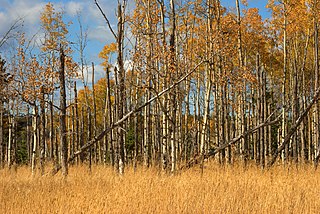
Aspen parkland refers to a very large area of transitional biome between prairie and boreal forest in two sections, namely the Peace River Country of northwestern Alberta crossing the border into British Columbia, and a much larger area stretching from central Alberta, all across central Saskatchewan to south central Manitoba and continuing into small parts of the US states of Minnesota and North Dakota. Aspen parkland consists of groves of aspen, poplar and spruce, interspersed with areas of prairie grasslands, also intersected by large stream and river valleys lined with aspen-spruce forests and dense shrubbery. This is the largest boreal-grassland transition zone in the world and is a zone of constant competition and tension as prairie and woodlands struggle to overtake each other within the parkland.
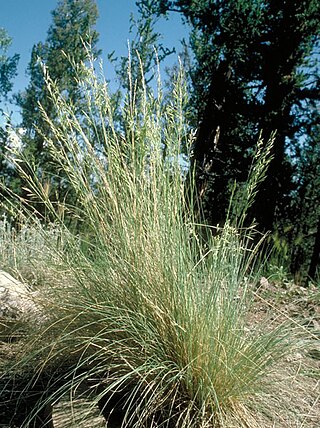
Festuca arizonica, commonly called Arizona fescue, is a grass found in western North America, in the southwest United States and northern Mexico. This species also has the common names mountain bunchgrass and pinegrass.

Festuca californica is a species of grass known by the common name California fescue.

The Blue Mountains ecoregion is a Level III ecoregion designated by the United States Environmental Protection Agency (EPA) in the Pacific Northwest, mainly in the state of Oregon, with small areas over the state border in Idaho and southeastern Washington. It is also contiguous with the World Wildlife Fund's Blue Mountain forests ecoregion.

The Northern Basin and Range ecoregion is a Level III ecoregion designated by the United States Environmental Protection Agency (EPA) in the U.S. states of Oregon, Idaho, Nevada, Utah, and California. It contains dissected lava plains, rolling hills, alluvial fans, valleys, and scattered mountain ranges in the northern part of the Great Basin. Although arid, the ecoregion is higher and cooler than the Snake River Plain to the north and has more available moisture and a cooler climate than the Central Basin and Range to the south. Its southern boundary is determined by the highest shoreline of Pleistocene Lake Bonneville, which once inundated the Central Basin and Range. The western part of the region is internally drained; its eastern stream network drains to the Snake River system.

The ecology of the Rocky Mountains is diverse due to the effects of a variety of environmental factors. The Rocky Mountains are the major mountain range in western North America, running from the far north of British Columbia in Canada to New Mexico in the southwestern United States, climbing from the Great Plains at or below 1,800 feet (550 m) to peaks of over 14,000 feet (4,300 m). Temperature and rainfall varies greatly also and thus the Rockies are home to a mixture of habitats including the alpine, subalpine and boreal habitats of the Northern Rocky Mountains in British Columbia and Alberta, the coniferous forests of Montana and Idaho, the wetlands and prairie where the Rockies meet the plains, a different mix of conifers on the Yellowstone Plateau in Wyoming, the montane forests of Utah, and in the high Rockies of Colorado and New Mexico, and finally the alpine tundra of the highest elevations.

Lomatium greenmanii is a rare species of flowering plant in the carrot family known by the common names Greenman's desertparsley and Greenman's biscuitroot. It is endemic to Oregon in the United States, where it is found only in the Wallowa Mountains of Wallowa County.

Lupinus sericeus is a species of flowering plant in the legume family known by the common name silky lupine or Pursh's silky lupine. It is native to western North America from British Columbia to Arizona and east to Alberta and Colorado.
Achnatherum richardsonii is a species of grass known by the common names Richardson's needlegrass, spreading needlegrass, and Canada mountain-ricegrass. It is native to northwestern North America, where it is distributed from Alaska and Yukon through the western Canadian provinces south to Colorado.
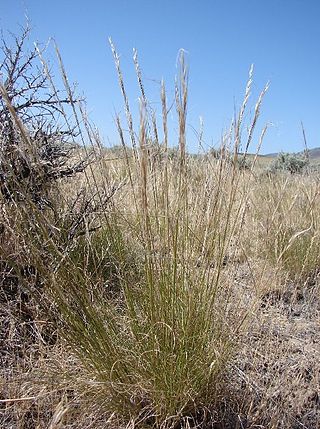
Eriocoma thurberiana is a species of grass known by the common name Thurber's needlegrass. It is native to the western United States, where it occurs from Washington to California and east to Montana and Wyoming.

Calamagrostis montanensis is a species of grass known by the common names plains reedgrass and prairie reedgrass. It is native to North America, where it is found across Canada from British Columbia to Manitoba and south to Colorado in the United States.
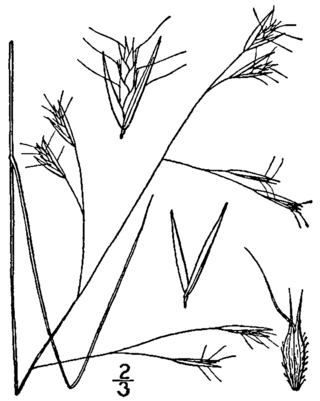
Danthonia compressa is a species of grass known by the common names mountain oatgrass, flattened oatgrass, and slender oatgrass.
Leymus innovatus is a species of grass known as downy ryegrass, boreal wildrye, hairy wildrye, fuzzyspike wildrye, northern wildrye, and northwestern wildrye. It is native to northern North America from Alaska to eastern Canada and south to Colorado.

Holodiscus dumosus is a species of flowering plant in the rose family, with the common names mountain spray, rock-spiraea, bush oceanspray, and glandular oceanspray.

Poa fendleriana is a species of grass known by the common name muttongrass. It is native to western North America, where its distribution extends from western Canada to northern Mexico.

Townsendia rothrockii is a species of flowering plant in the family Asteraceae known by the common name Rothrock's Townsend daisy. It is endemic to Colorado in the United States, where there are 35 occurrences across thirteen counties. Reports of the plant from New Mexico are false.
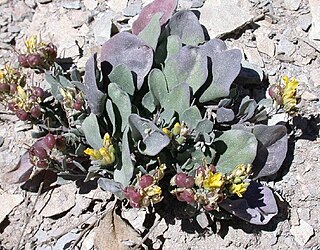
Physaria pruinosa is a species of flowering plant in the family Brassicaceae known by the common names Pagosa Springs bladderpod and frosty bladderpod. It is native to Colorado and New Mexico in the United States.
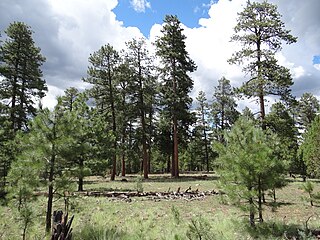
Ponderosa pine forest is a plant association and plant community dominated by ponderosa pine and found in western North America. It is found from the British Columbia to Durango, Mexico. In the south and east, ponderosa pine forest is the climax forest, while in the more northern part of its range, it can transition to Douglas-fir or grand fir, or white fir forests. Understory species depends on location. Fire suppression has led to insect outbreaks in ponderosa pine forests.
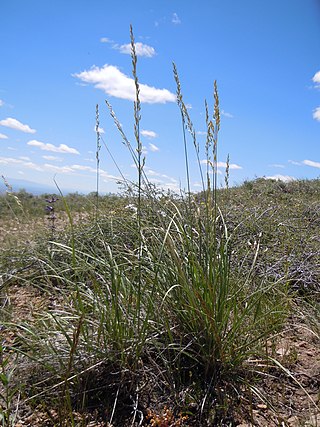
Festuca kingii is a species of grass in the family Poaceae known by the common names spike fescue and King's fescue. It is native to the western United States from Oregon and California east to Nebraska and Kansas.



















